Toshiba 1600EP User Manual

Uninterruptible Power System (UPS) single phase - 3.6-RoHS/3.6/6/8/10/14/18/22
1600EP SERIES
instruction MANUAL
March 2008
Part # 55288-002
Manufactured in the USA
© Copyright 2008 TOSHIBA International Corporation All rights reserved.

Product Use and Warranty Restrictions
The Toshiba products listed in this document are intended for usage in general electronics applications
(computer, personal equipment, office equipment, measuring equipment, industrial robotics, domestic appliances, etc.). These Toshiba products are neither intended nor warranted for usage in equipment that requires extraordinarily high quality and/or reliability or where a malfunction or failure may cause loss of human life or bodily injury (Unintended Usage). Unintended Usage include atomic energy control instruments, airplane or spaceship instruments, transportation instruments, traffic signal instruments, combustion control instruments, surgical operating room or life-support equipment, all types of safety devices, etc.. Unintended Usage of Toshiba products listed in this document shall be made at the customer’s own risk.
NOTICE
PLEASE INFORM TOSHIBA INTERNATIONAL CORPORATION OR AUTHORIZED REPRESENTATIVE IN CASE OF INCONSISTENCIES, OMISSIONS, OR QUESTIONS.
The instructions contained in this manual are not intended to cover all of the details or variations in equipment, or to provide for every possible contingency concerning installation, operation, or maintenance.
Should further information be required or if problems arise which are not covered sufficiently, contact your Toshiba sales office.
The contents of this instruction manual shall not become a part of or modify any prior or existing agreement, commitment, or relationship. The sales contract contains the entire obligation of Toshiba International Corporation UPS Division. The warranty contained in the contract between the parties is the sole warranty of Toshiba International Corporation UPS Division and any statements contained herein DO NOT create new warranties or modify the existing warranty.
Any electrical or mechanical modifications to this equipment without prior written consent of Toshiba
International Corporation will void all warranties and may void the UL/CUL listing. Unauthorized modifications can also result in personal injury, loss of life, or destruction of the equipment.
QUALIFIED PERSONNEL ONLY
Qualified Personnel are those that have the skills and knowledge relating to the construction, installation, operation, and maintenance of the electrical equipment and has received safety training on the hazards involved (Refer to the latest edition of NFPA 70E for additional safety
requirements).
1600EP Series Instruction Manual

UNINTERRUPTIBLE POWER System (UPS)
Please complete the following information and retain for your records.
Unless otherwise specified, the warranty period for the UPS or UPS part is 36 months from the shipment date (see Toshiba International Corporation bill of lading).
Unless otherwise specified, the warranty period for a UPS battery is 24 months from the shipment date
(see Toshiba International Corporation bill of lading).
JOB NUMBER
MODEL NUMBER
SERIAL NUMBER
APPLICATION
SHIPMENT DATE
INSTALLATION DATE
INSPECTED BY
1600EP Series Instruction Manual

Purpose
This manual provides information on how to safely install your Toshiba International Corporation power electronics product. This manual includes a section of general safety instructions that describes the warning labels and symbols that are used throughout the manual. Read the manual completely before installing, operating, or performing maintenance on this equipment.
This manual and the accompanying drawings should be considered a permanent part of the equipment and should be readily available for reference and review. Dimensions shown in the manual are in metric and/or the English customary equivalent.
Toshiba International Corporation reserves the right, without prior notice, to update information, make product changes, or discontinue any product or service identified in this publication.
Toshiba is a registered trademark of the Toshiba Corporation. All other product or trade references appearing in this manual are registered trademarks of their respective owners.
Toshiba International Corporation shall not be liable for direct, indirect, special, or consequential damages resulting from the use of the information contained within this manual.
This manual is copyrighted. No part of this manual may be photocopied or reproduced in any form without the prior written consent of Toshiba International Corporation.
© Copyright 2008 Toshiba International Corporation All rights reserved.
Printed in the U.S.A.
Toshiba Customer Support Center
Contact the Toshiba Customer Support Center for assistance with application information or for any problems that you may experience with your Uninterruptible Power System (UPS).
Toshiba Customer Support Center
8 a.m. to 5 p.m. (CST) - Monday through Friday USA Toll Free (877) 867-8773
Tel (713) 466-0277
Fax (713) 466-8773
You may also contact Toshiba by writing to:
Toshiba International Corporation
13131 West Little York Road
Houston, Texas 77041-9990
Attn: UPS Product Manager
For further information on Toshiba products and services, please visit our website at:
www.toshiba.com/ind
1600EP Series Instruction Manual

This page intentionally left blank.
1600EP Series Instruction Manual

Table of Contents |
|
General Safety Instructions............................................................................. |
1 |
Symbols.................................................................................................... |
1 |
Signal Words............................................................................................ |
2 |
IMPORTANT SAFETY INSTRUCTIONS............................................................ |
3 |
QUALIFIED PERSONNEL ONLY............................................................. |
3 |
INSTRUCTIONS IMPORTANTES CONCERNANT LA SÉCURITÉ................... |
4 |
Product Description.......................................................................................... |
5 |
Application and Use................................................................................. |
5 |
Output Rating........................................................................................... |
5 |
Power Backup.......................................................................................... |
5 |
Power Conditioning.................................................................................. |
5 |
Inspection/Storage/Disposal............................................................................ |
6 |
Inspection................................................................................................. |
6 |
Storage..................................................................................................... |
6 |
Disposal.................................................................................................... |
6 |
Installation Precautions.................................................................................... |
7 |
Conductor Routing and Grounding................................................................. |
7 |
Operating Precautions...................................................................................... |
8 |
Equipment Warning Labels.............................................................................. |
9 |
UPS Connections.............................................................................................. |
11 |
Communication Interfaces............................................................................... |
12 |
UPS Stop Signal Operation ..................................................................... |
13 |
RS-232C................................................................................................... |
14 |
RemotEye II Network Card....................................................................... |
14 |
UPS Specifications........................................................................................... |
15 |
Operating the UPS............................................................................................ |
21 |
Battery Backup Time and Discharge Process ........................................ |
21 |
Starting the UPS....................................................................................... |
22 |
Battery Recharging................................................................................... |
23 |
Online Mode....................................................................................................... |
24 |
Online Mode (Run operation) .............................................................................. |
24 |
Static-Bypass Mode (Stop operation)....................................................... |
24 |
Battery Backup Mode (On batteries)........................................................ |
25 |
EPO (Emergency Power Off) Function.................................................... |
25 |
Audible Alarm Functions........................................................................... |
26 |
Display and Keys.............................................................................................. |
27 |
Front Panel Layout................................................................................... |
27 |
Liquid Crystal Display (LCD) Functions.................................................... |
27 |
1600EP Series Instruction Manual |
|

Operating Keys......................................................................................... |
28 |
Light Emitting Diodes (LED)..................................................................... |
28 |
Display Screens................................................................................................ |
29 |
Screen Arrangement................................................................................ |
29 |
System Overview Screens....................................................................... |
29 |
UPS Start-Up Screens Sequence............................................................ |
29 |
Data Display Screens............................................................................... |
31 |
Special Display Screens........................................................................... |
32 |
Data Setting Screens............................................................................... |
33 |
System Warning Messages...................................................................... |
39 |
System Fault Messages........................................................................... |
40 |
Status Change Indications....................................................................... |
41 |
UPS Protection System.................................................................................... |
42 |
System Protection Features..................................................................... |
42 |
System Protection Functions ................................................................... |
42 |
Preventive Maintenance/Parts Replacement.................................................. |
44 |
Preventive Maintenance........................................................................... |
44 |
Parts Replacement................................................................................... |
44 |
Optional Receptacle Panel Installation Instructions..................................... |
45 |
Optional MB (Maintenance Bypass) Units...................................................... |
46 |
External Layouts/Dimensions/Shipping Weights.......................................... |
48 |
Dimensional Data .................................................................................... |
48 |
Electrical Conduit Knock-out Data............................................................ |
48 |
Unit and Shipping Weights....................................................................... |
48 |
Index................................................................................................................... |
51 |
ii |
1600EP Series Instruction Manual |
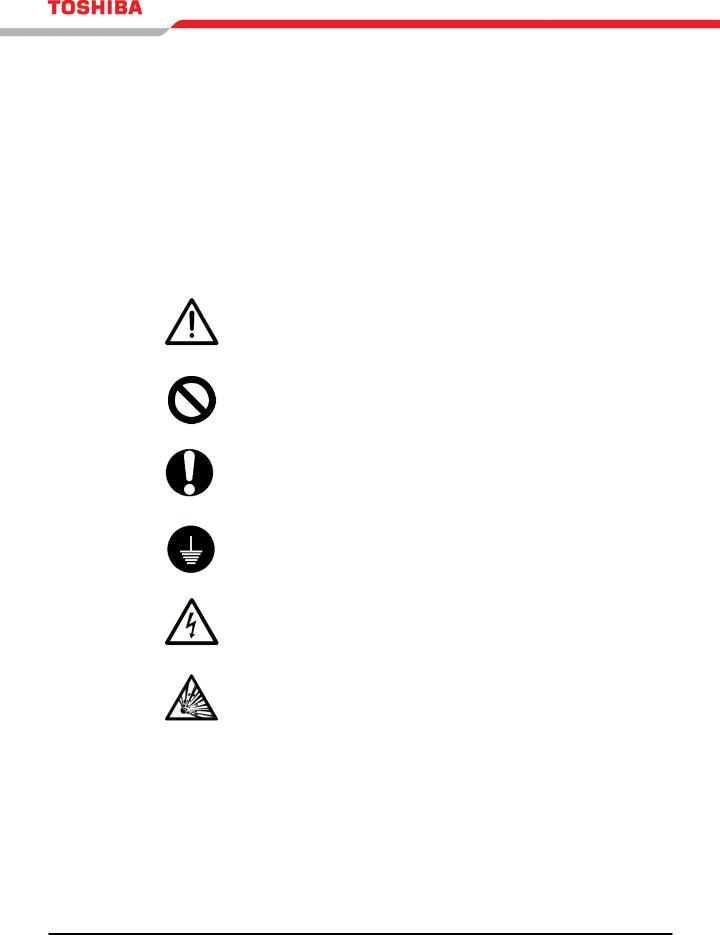
General Safety Instructions
DO NOT attempt to transport, install, operate, maintain or dispose of this equipment until you have read and understood all of the product safety information provided in this manual.
Symbols
The symbols listed below are used throughout this manual. When symbols are used in this manual they will include important safety information that must be carefully followed.
Safety Alert Symbol indicates that a potential personal injury hazard exists.
Prohibited Symbol indicates DO NOT take action.
Mandatory Symbol indicates that the following instruction is required.
Ground Symbol indicates the location of the equipment grounding conductor.
Electrical - Voltage & Shock Hazard Symbol indicates parts inside may cause electric shock.
Explosion Hazard Symbol indicates parts may explode.
1600EP Series Instruction Manual

Signal Words
The signal words listed below are used throughout this manual. When the words DANGER, WARNING, CAUTION and ATTENTION are used in this manual they will include important safety information that must be carefully followed.
 DANGER
DANGER
 warning
warning
 caution
caution
caution
attention
The word DANGER in capital letters preceded by the safety alert symbol indicates that an imminently hazardous situation exists, if not avoided, will result in loss of life or serious injury to personnel.
The word WARNING in capital letters preceded by the safety alert symbol indicates that a potentially hazardous situation exists, if not avoided, may result in loss of life or serious injury to personnel.
The word CAUTION in capital letters preceded by the safety alert symbol indicates that a potentially hazardous situation exists, if not avoided, may result in minor or moderate injury.
The word CAUTION in capital letters without the safety alert symbol indicates a potentially hazardous situation exists, if not avoided, may result in equipment and property damage.
The word ATTENTION in capital letters without the safety alert symbol indicates a potentially hazardous situation exists, if not avoided, may result in equipment and property damage.
1600EP Series Instruction Manual

IMPORTANT SAFETY INSTRUCTIONS
This manual contains important instructions that should be followed during the installation and maintenance of the UPS and its batteries.
Hardwire-type UPS units are not equipped with an over-current protection device nor an output disconnect for the AC output. A circuit breaker should be provided by the user between the UPS output and the load input. This device should be rated as follows:
240VAC |
3.6RoHS kVA |
3.6 kVA |
6 kVA |
8 kVA |
10 kVA |
14 kVA |
18 kVA |
22 kVA |
RATING |
20 A |
20 A |
30 A |
40 A |
60 A |
80 A |
125 A |
150 A |
The nominal battery voltages for these models are as follows:
BATTERY |
3.6RoHS kVA |
3.6 kVA |
6 kVA |
8 kVA |
10 kVA |
14 kVA |
18 kVA |
22 kVA |
VOLTAGE |
144 Vdc |
216 Vdc |
216 Vdc |
288 Vdc |
288 Vdc |
288 Vdc |
288 Vdc |
288 Vdc |
Servicing of the batteries should only be performed by a qualified factory authorized representative who is knowledgeable of batteries and the required precautions. Keep unauthorized personnel away from batteries. To arrange for battery replacement, contact your nearest factory authorized service center.
1.Turn off, lockout, and tagout all equipment before connecting the power wiring to the equipment ow when performing maintenance.
2.Hardwire type UPS units are not equipped with an over-current protection device, nor do they have an output disconnect for the AC output. Therefore, a user-installed circuit breaker should be provided between the UPS output and the load input.
3.The maximum ambient operating temperature is 104 °F (40 °C).
4.Battery servicing should be performed by qualified Toshiba representative only.
5.Unauthorized personnel should not service batteries.
6.Contact your Toshiba authorized service center for battery replacement.
QUALIFIED PERSONNEL ONLY
Qualified personnel is one that has the skills and knowledge relating to the construction, installation, operation, and maintenance of the electrical equipment and has received safety training on the hazards involved (Refer to the latest edition of NFPA 70E for additional safety requirements).
Qualified personnel shall:
1.Have read the entire operation manual.
2.Be trained and authorized to safely energize, de-energize, ground, lockout and tag circuits and equipment, and clear faults in accordance with established safety practices.
3.Be trained in the proper care and use of protective equipment such as safety shoes, rubber gloves, hard hats, safety glasses, face shields, flash clothing, etc., in accordance with established safety practices.
4.Be trained in rendering first aid.
5.Be knowledgeable of batteries and the required handling and maintenance precautions.
For further information on workplace safety visit www.osha.gov.
1600EP Series Instruction Manual
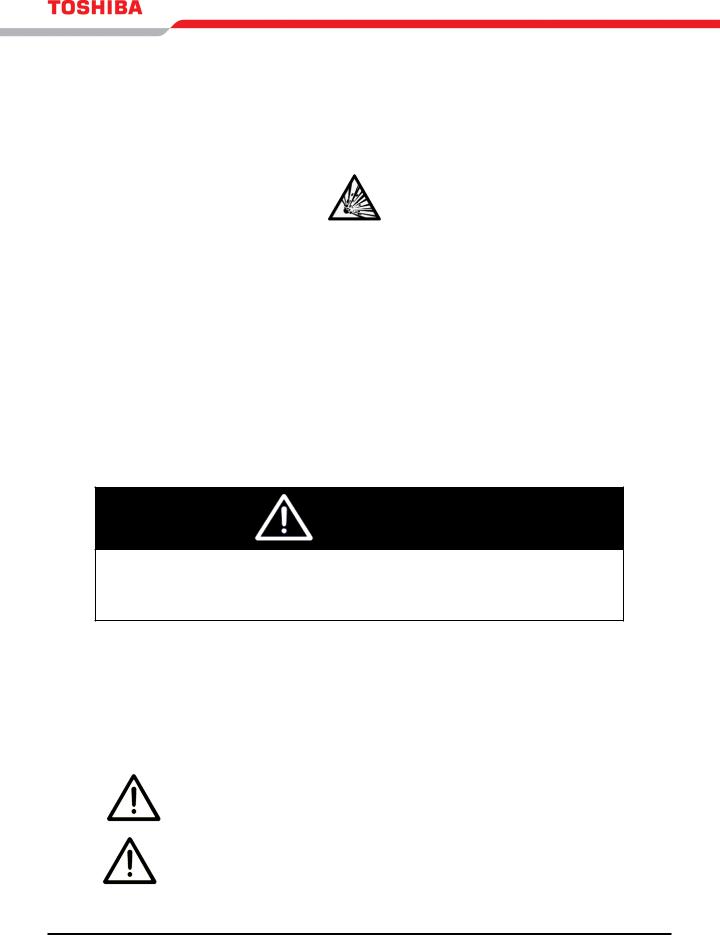
 Caution
Caution
 Caution
Caution
 Caution
Caution
Misuse of this equipment may result in human injury and equipment damage. In no event will Toshiba Corporation be responsible or liable for either indirect or consequential damage or injury that may result from the use of this equipment.
DO NOT dispose of the battery module in a fire. The batteries inside may explode.
DO NOT open or mutilate the batteries. Released electrolyte is harmful to the eyes and skin and could also be toxic.
To be performed by Qualified Personnel Only:
1.Verify that the UPS is off and that the power cord is disconnected from the power source.
2.Remove watches, rings or other metal objects.
3.Use tools with insulated handles to prevent inadvertent shorts.
4.Wear rubber gloves and boots.
5.DO NOT place tools or any metal parts on top of batteries.
6.Determine if the battery is inadvertently grounded. If inadvertently grounded, remove source of ground.
Warning
Contact with any part of a grounded battery can result in electrical shock.
The likelihood of shock will be reduced if such grounds are removed prior to installation or maintenance.
INSTRUCTIONS IMPORTANTES CONCERNANT LA SÉCURITÉ
CONSERVER CES INSTRUCTIONS
Cette notice contient des instructions importantes concernant la sécurité.
Attention
Attention
Une battery peut présenter un risque de choc électrique, de brûlure par transfert d’ énergie.
L’ élimination des batteries est règlementèe. Consulter les codes locaux à cet effet.
1600EP Series Instruction Manual
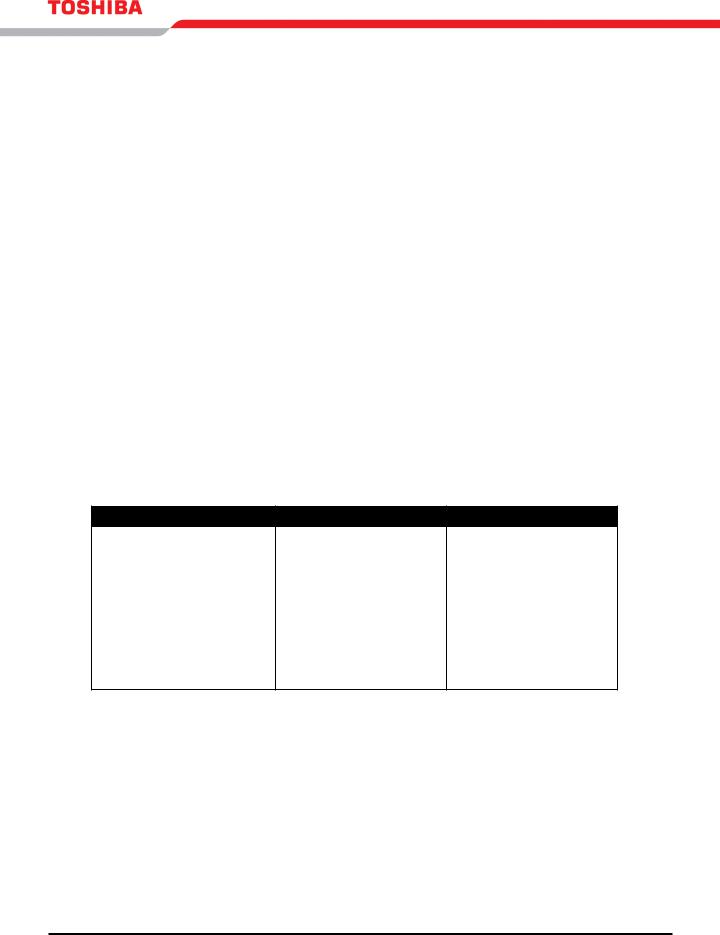
Product Description
An uninterruptible power system is a system that is installed between the commercial power and the load equipment. The UPS provides steady AC output power during commercial power short-term blackouts or brownouts. This power is provided for a long enough time so that the load can be shut down in an orderly fashion. This prevents loss of data and possible damage to both hardware and software.
During normal operation, the UPS uses commercial AC power. It absorbes all of the high voltage spikes and transients caused by switching and faults, and all of the common-mode and normal mode noise which is associated with commercialAC power. The UPS converts it all to flat DC power. From this power, the UPS charges its batteries and generates its own extremely high quality AC waveform output. The result of this process is maximum power conditioning and regulation.
If theAC power supplied to the UPS drops below a specified voltage level, the unit’s batteries automatically begin supplying power instead of receiving it. This insures that the loads connected to the UPS continue to receive power with no interruption. When AC input power becomes available again, operation returns to normal. The unit’s batteries begin to recharge so they will be ready for the next power interruption.
Application and Use
Toshiba 1600EP Series of on-line uninterruptible power system (UPS) provides continuous computergrade AC power in a compact, high performance, and energy efficient unit. The UPS unit assures safe and reliable operation of critical office equipment. This can range from word processors and personal computers to mini-computers and local area networks. All units feature an audible alarm which sounds if the battery voltage drops below a specified minimum during use. This is an additional aid to help in retaining the valuable office data banks. All units allow for computer interfacing.
Output Rating
Toshiba 1600EP Series (208/240V) offers UPS models with the following capacities:
MODEL |
Output Capacity @ 240 V |
Output kW @ .85PF 240 V |
UE3G2L036C61TRoHS* |
3.6 kVA |
3.1 kW |
UE3G2L036C61T |
3.6 kVA |
3.1 kW |
UE3G2L060C61T |
6 kVA |
5.1 kW |
UE3G2L080C61T |
8 kVA |
6.8 kW |
UE3G2L100C61T |
10 kVA |
8.5 kW |
UE3G2L140C61T |
14 kVA |
11.9 kW |
UE3G2L180C61T |
18 kVA |
15.3 kW |
UE3G2L220C61T |
22 kVA |
18.7 kW |
* UE3G2L036C61TRoHS is RoHS compliant with the batteries being exempt from the directive.
Power Backup
When an electrical power failure occurs, the UPS’s internal batteries automatically supply back-up power to the load without interruption. For example, when used to support a computer, the UPS back-up assures enough additional time to complete the activity and store the data. This allows an orderly shutdown after a power failure has occurred.
Power Conditioning
When commercial power is present, the UPS supplies conditioned power to the load while maintaining its batteries in a charged condition. The UPS protects against the normal, everyday problems associated with heavy use of raw commercial power, including power sags, surges, signal interference, and spikes. This protection keeps power-line problems from reaching your load, where they can cause equipment to operate erratically, or damage software and hardware.
1600EP Series Instruction Manual

Inspection/Storage/Disposal
Inspection
Upon receipt of the UPS, an inspection for shipping damage should be performed. Use caution when removing the unit from the pallet. Refer to labels or documentation attached to packing material.
Unpacking
Check the unit for loose, broken, bent or otherwise damaged parts. If damage has occurred during shipping, keep all original crating and packing materials for return to the shipping agent. The warranty does not apply to damage incurred during shipping. Ensure that the rated capacity and the model number specified on the nameplate conform to the order specifications.
Storage
During periods of non-use, the following guidelines are recommended for storage.
Storage Preparation
1.Power up the UPS and allow it to operate with no load for 24 hours to fully charge the batteries.
2.Stop the unit (see Stop Operation on page 25).
3.Place the MCCB switch (see page 47 for location) in the Off position.
Storing Conditions
•For best results, store the UPS in the original shipping container and place on a wood or metal pallet.
•Storage temperature: -4 – 104 °F (-20 – 40 °C).
•The optimum storage temperature is 70 °F (21 °C). A higher ambient temperature will require recharging more frequently during storage.
Avoid storage locations that:
•Are subject to extreme temperature changes or high humidity.
•Are subject to high levels of dust or metal particles.
•Are subject to excessive vibration.
•Have inclined floor surfaces.
Storage Maintenance
•If stored at an ambient temperature less than 68 °F (20 °C), recharge the batteries every 9 months.
•If stored at an ambient temperature of 68 – 86 °F (20 – 30 °C), recharge the batteries every 6 months.
•If stored at an ambient temperature of 86 – 104 °F (30 – 40 °C), recharge the batteries every 3 months.
Disposal
Please contact your local or state environmental agency for details on disposal of electrical components and packaging in your particular area.
It is illegal to dump lead-acid batteries in landfills or dispose of improperly.
Please help our Earth by contacting the environmental protection agencies in your area, the battery manufacturer, or call Toshiba toll-free at (877) 867-8773 for more information about recycling.
1600EP Series Instruction Manual
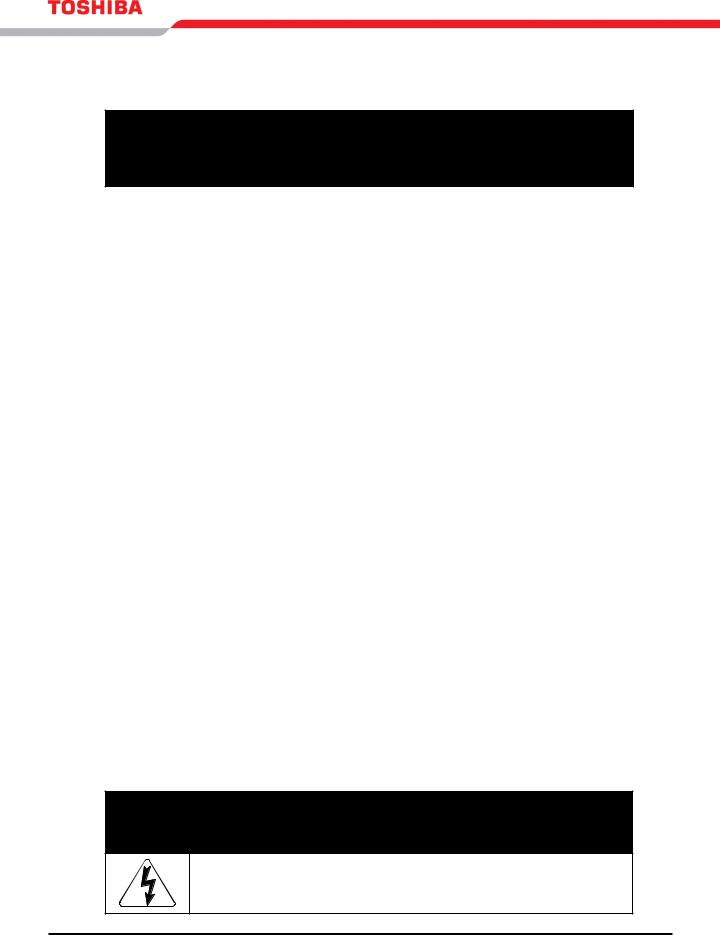
Installation Precautions
 Caution
Caution
1.Install the unit in a well-ventilated location; allow at least 4 inches (10 cm) on all sides for air ventilation and for maintenance.
2.Install the unit in a stable, level and upright position that is free of excessive vibration.
3.Install the unit where the ambient temperature is within the range specified on pages 16 and 19.
4.DO NOT install the UPS in areas that are subject to high humidity.
5.DO NOT install the UPS in areas that allow exposure to direct sunlight.
6.DO NOT install the UPS in areas that allow exposure to high levels of airborne dust, metal particles, or flammable gases.
7.DO NOT install the UPS in areas near sources of electrical noise. Ensuring a proper earth ground will reduce the effects of electrical noise and will reduce the potential for electrical shock.
8.DO NOT install the UPS in areas that would allow fluids or any foreign object to get inside the
UPS.
9.The UPS generates and can radiate radio-frequency energy during operation. Although RFI noise filters are installed inside of the unit, there is no guarantee that the UPS will not influence some sensitive devices that are operating near by. If such interference is experienced, the UPS should be installed farther away from the affected equipment and/or powered from a different source than that of the affected equipment.
10.The user should provide output over-current protection for hardwired UPS systems. See the section titled Specifications on page 15 and 18 for the device rating.
11.After ensuring that all power sources are turned off and isolated in accordance with established lockout/tagout procedures, connect the power source wiring of the correct voltage to the input terminals of the UPS.
12.Connect the output terminals of the UPS to the load (refer to NEC Article 300 – Wiring Methods and Article 310 – Conductors For General Wiring). Size the branch circuit conductors in accordance with NEC Table 310.16.
Conductor Routing and Grounding
1.Use separate metal conduits for routing the input power, output power, and control circuits.
2.Follow the wire size and tightening torque specifications listed on page 11.
3.Always ground the unit to reduce the potential for electrical shock and to help reduce electrical noise.
4.A separate ground cable should be run inside the conduit with the input power, output power, and control circuits.
 Warning
Warning
THE METAL OF CONDUIT IS NOT AN ACCEPTABLE GROUND.
1600EP Series Instruction Manual
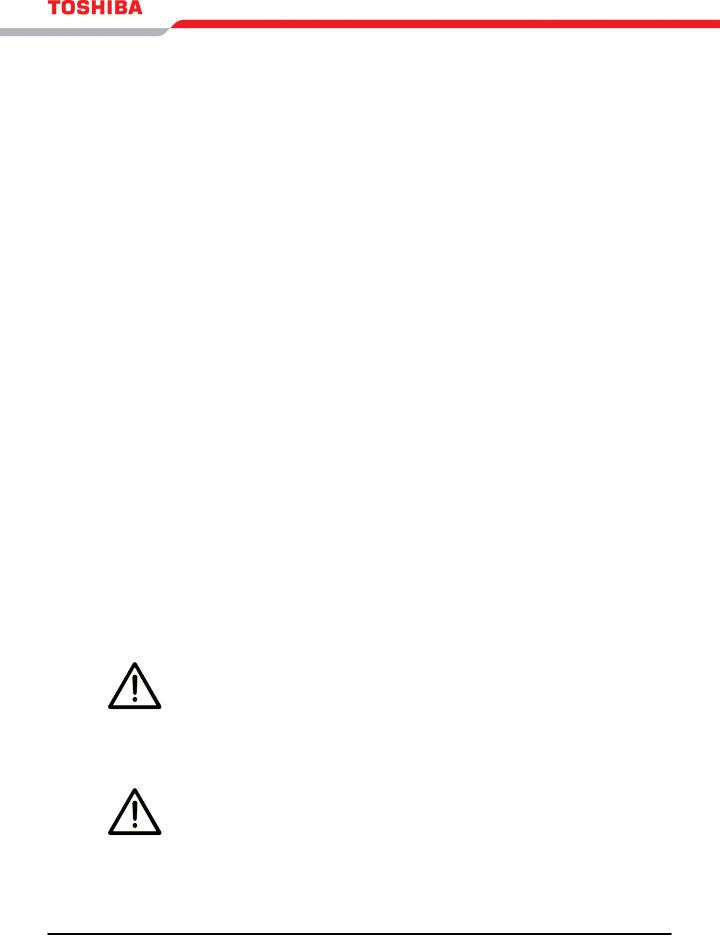
Operating Precautions
1.The UPS should not be powered up until the entire operation manual has been read.
2.The voltage of the input power source must be within the range of +10% to -30% of the rated input voltage. The input frequency must be within the rated input frequency range. Voltages and frequencies outside of the permissible range may activate the internal protection devices.
3.The UPS should not be used with a load that has a rated input that is greater than the rated output of the UPS.
4.DO NOT use the UPS to provide power to motors that require high starting current or with motors that require a long starting time, such as vacuum cleaners and machine tools (oversizing the UPS for lock rotor current would be required).
5.DO NOT insert metal objects or combustible materials in the ventilation slots of the UPS.
6.DO NOT place, hang, or paste any objects on the exterior surfaces of the UPS.
7.The capacitors of the UPS maintain a residual charge for a while after turning the UPS off. The required discharge time for each UPS typeform is provided via a cabinet label and a CHARGE LED. Wait for at least the minimum time indicated on the label and ensure that the CHARGE LED has gone out before opening the door of the UPS once the UPS power has been turned off.
8.DO NOT attempt to disassemble, modify, or repair the UPS. Call your Toshiba sales representative for repair information.
9.Turn the power on only after installing ALL of the covers.
10.DO NOT remove any covers of the UPS when the power is on.
11.If the UPS should emit smoke, produce an unusual odor, or make sound, turn the power off immediately.
12.The heat sink and other components may become extremely hot to the touch. Allow the unit to cool before touching these items.
13.Warning signs should be placed on or near the load as a notification that the load is being powered by the UPS.
14.Additional warnings and notifications shall be posted at the equipment installation location as deemed required by Qualified Personnel.
Warning
caution
When operating in the inverter mode, placing the breaker in the OFF position will switch the UPS to the battery backup mode. The output of the UPS will continue uninterrupted to the load. The unit must be in the bypass mode at the time that the breaker is placed in the OFF position for the UPS to shutdown power to the load.
Wait at least 5 minutes after an Emergency Power Off (EPO) before resetting the UPS breaker. This allows the UPS circuitry to fully discharge. The UPS could be damaged if the unit is not fully discharged before the breaker is reset.
1600EP Series Instruction Manual
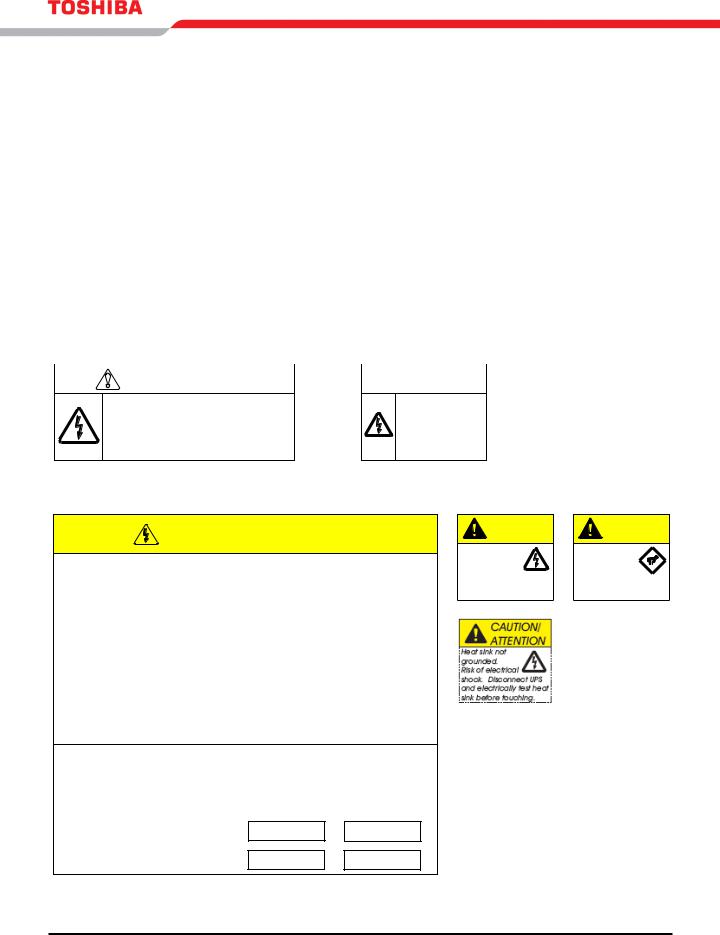
Equipment Warning Labels
Below and on the following page are examples of warning labels that may be attached to either the interior or exterior of the UPS. Do not remove or cover any of the labels. If the labels are damaged or if additional labels are required, contact your equipment representative for additional labels.
These labels are placed to provide useful information or to indicate an imminently hazardous situation that may result in severe equipment/property damage, serious injury, or loss of life if instructions are not followed.
48518
DANGER/ATTENTION |
|
DANGER |
|
|
|
Risk of electrical shock. Do not touch uninsulated
battery terminals. Batteries should be serviced by Battery fuse is always qualified service representative only. Miswiring of live. Risk of electrical battery could result in electrcal shock and/or fire. shock.Check fuse
Risque de choc electrique. Le circuit des batteries voltage and disconnect nest pas esolede secteur. Les cosses des batteries external batteries peuvent presenter une tension dangereuse part before changing fuse. rapport a la terre. Verifier avant de toucher.
48524
CAUTION/ATTENTION
Risk of electric shock. Do not remove cover. NO USER SERVICEABLE PARTS
INSIDE. Refer servicing to qualified service personnel.
To reduce the risk of fire or electric shock, install in a temperature and humidity controlled indoor area free of conductive contaminants.
En cas utilisation en atmosphere controlee. Consulter la notice technique.
Note: Service personnel only. Hazardous live parts inside the UPS are energized from the battery supply even when the input AC power is disconnected.
Capacitors store hazardous energy. Do not remove cover until 5 minutes after disconnecting all sources of supply.
Battery backup time, which was factory-set at a predetermined level, decreases gradually between service periods. The batteries should be replaced every three years after the last servicing, the date of which is written on the ID plate located on the rear side of the UPS unit, or in the boxes below.
Date of last battery charge:
CAUTION/
ATTENTION
Do not disconnect while unit is operating on battery power. Nes pas debrancher sous charge.
CAUTION
HOT SURFACE.
Contact may  result in burn injury. Allow equipment to cool before servicing.
result in burn injury. Allow equipment to cool before servicing.
1600EP Series Instruction Manual
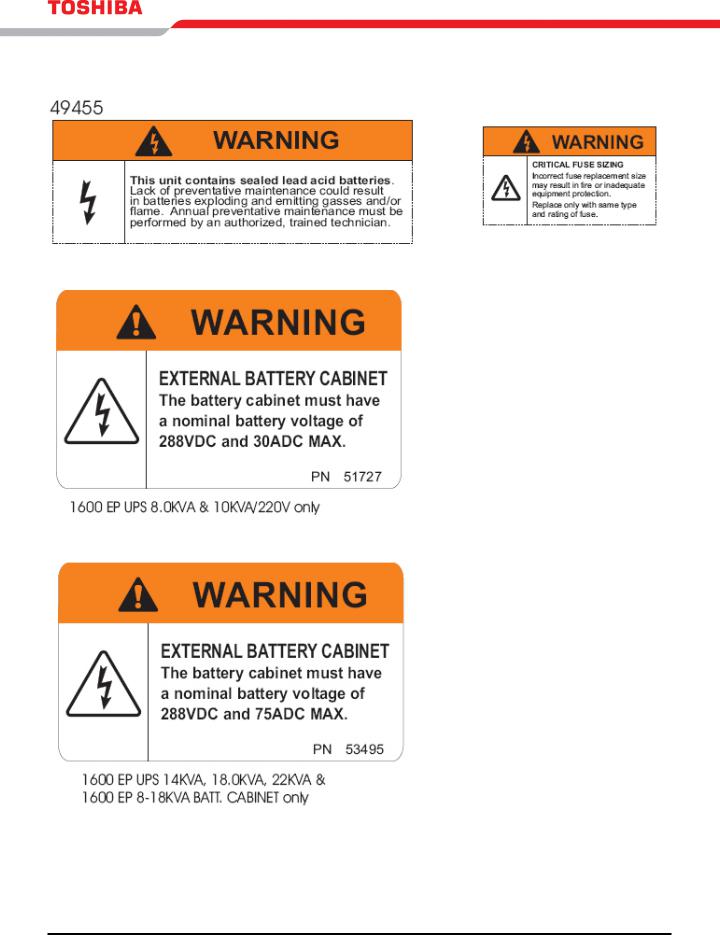
10 |
1600EP Series Instruction Manual |
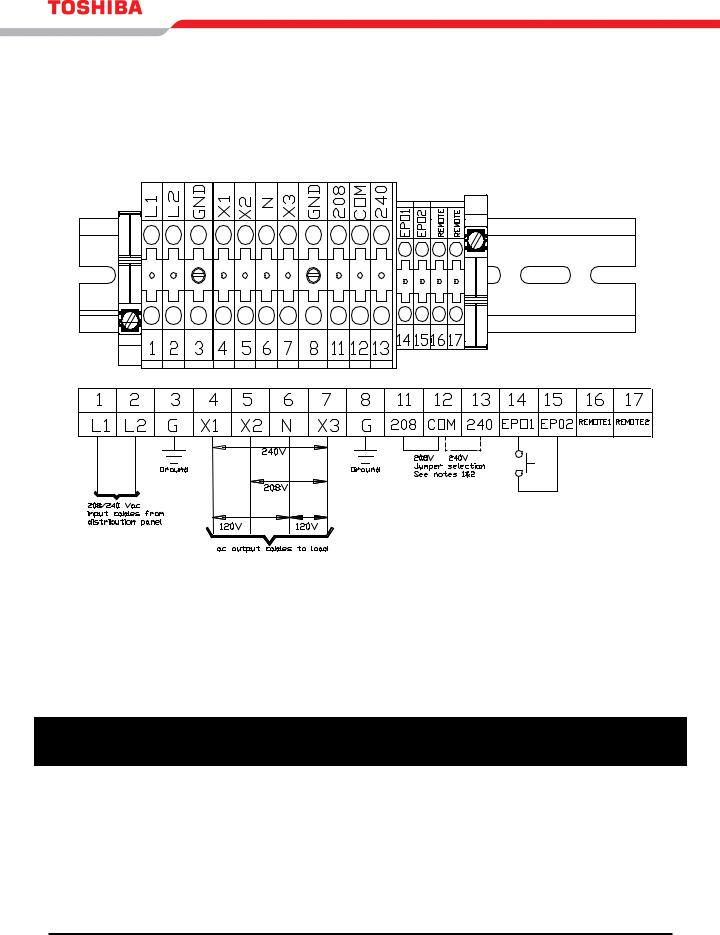
UPS Connections
Terminal Block
The following illustration is a detail view of the terminal block and wiring connections used for 208/240 volt units (see pages 49-50 for terminal block location).
Note 1 – If AC input power is 208 Vac rated, short terminals 11 and 12 with a jumper wire. DO NOT jumper terminal 13 to 12 or 11.
Factory Setting is 208Vac. Use the jumper wire provided by Toshiba. DO NOT add any additional jumpers.
Note 2 – If AC input power is 240 Vac rated, short terminals 12 and 13 with a jumper wire. DO NOT jumper terminal 11 to 12 or 13. Use the jumper wire provided by Toshiba. DO NOT add any additional jumpers.
Wire Size and Tightening Torque
Use the following table to select the recommended wire size and terminal lug tightening torque for I/O wire connections.
|
Terminal |
AWG |
AWG |
AWG |
AWG |
AWG |
AWG |
AWG |
Tightening |
||
Item |
3.6RoHS |
Torque |
|||||||||
Number |
3.6 kVA |
6 kVA |
8 kVA |
10 kVA |
14-18 kVA |
22 kVA |
|||||
|
kVA |
lb.-in. (N•m) |
|||||||||
|
|
|
|
|
|
|
|
|
|||
AC Input Lines |
1 and 2 |
12 (8) |
12 (8) |
10 (8) |
8 |
(1/0) |
6 (1/0) |
4 (1/0) |
1 (1/0) |
14.2 (1.56) |
|
AC Output Lines |
4, 5, and 7 |
12 (8) |
12 (8) |
10 (8) |
8 |
(1/0) |
6 (1/0) |
4 (1/0) |
1 (1/0) |
14.2 (1.56) |
|
AC Output Neutral |
6 |
12 (8) |
12 (8) |
10 (8) |
8 |
(1/0) |
6 (1/0) |
4 (1/0) |
1 (1/0) |
14.2 (1.56) |
|
Ground |
3 and 8 |
12 (8) |
12 (8) |
10 (8) |
8 |
(1/0) |
6 (1/0) |
4 (1/0) |
1 (1/0) |
14.2 (1.56) |
|
EPO Switch |
14 and 15 |
16 |
16 |
16 |
|
16 |
16 |
16 |
16 |
9.0 (0.99) |
|
Remote Switch |
16 and 17 |
16 |
16 |
16 |
|
16 |
16 |
16 |
16 |
9.0 (0.99) |
|
Note: Wire size presented as the recommended size followed by a bold number in () that is the maximum wire size the terminal block can accommodate. See page 48 for knock-out hole sizes on the back of each model.
1600EP Series Instruction Manual |
11 |
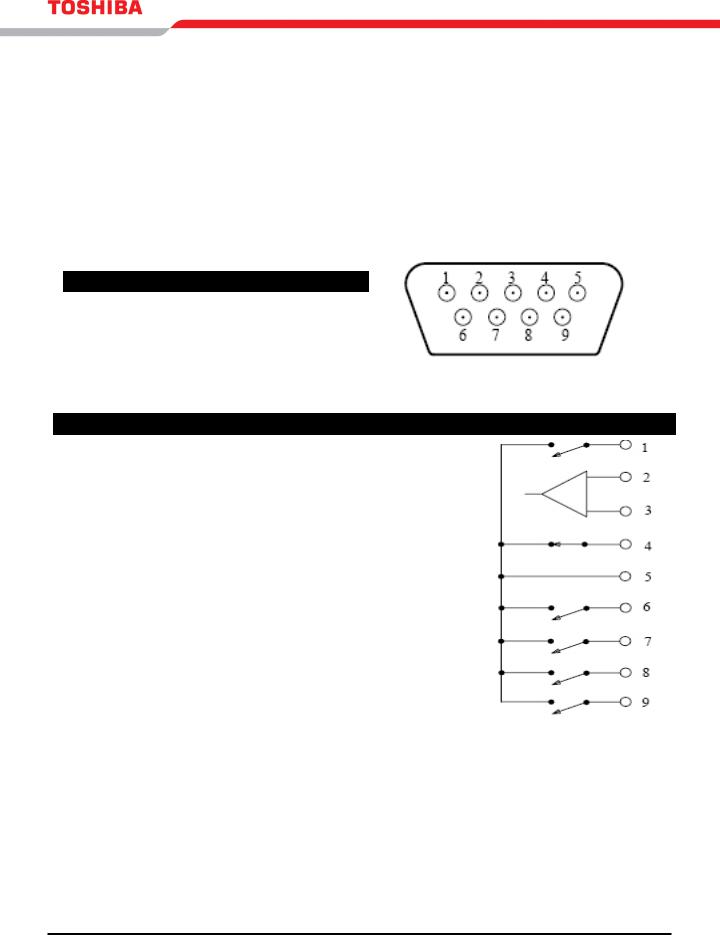
Communication Interfaces
Remote Contacts
The remote contacts interface is provided as a set of solid state relay switch contacts. The switches are available through a DB9 male connector on the rear of the UPS. The following chart shows the pin assignment for each signal.
Maximum current carrying capacity |
DB9 Male Connector Outline |
|
Of the switch |
(Facing connector) |
|
|
|
|
Voltage |
Current |
|
48 Vdc Peak |
100 mA peak |
|
30 Vac rms |
70 mA rms |
|
(42 Vac peak) |
(100 mA peak) |
|
Pin |
Signal Function |
Logic |
In the UPS |
1 |
Fault Signal |
Closed when fault detected |
|
|
|
|
|
2 |
UPS stop common |
Backup stop when the level |
|
3 |
UPS stop signal input |
changes from Low (-3 to -15 V) to |
|
High (+3 to +15 V) |
|
||
|
|
|
|
|
|
|
|
4 |
Normal input power supply |
Closed with normal supply power |
|
|
|
|
|
5 |
Signal common |
Common signal return |
|
|
|
|
|
6 |
Bypass operation |
Closed during bypass operation |
|
|
|
|
|
7 |
Battery voltage drop |
Closed at voltage drop |
|
|
|
|
|
8 |
UPS operation |
Closed during inverter operation |
|
|
|
|
|
9 |
Power failure signal |
Closed at power failure |
|
|
|
|
|
Note Pin switches are shown in their inactive states. For example, if battery voltage is low, pin 7 will be connected to pin 5.
12 |
1600EP Series Instruction Manual |
